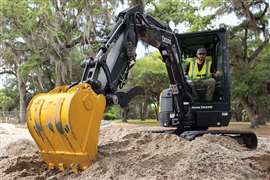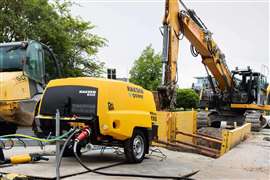Read this article in Français Deutsch Italiano Português Español
Propane set to seize its moment as a “future fuel”
06 March 2024
Companies share propane’s benefits in power generation applications
Energy is becoming an increasingly fragile commodity, said Gavin Hale, vice president of product development and power generation, Propane Education & Research Council (PERC), at a press briefing during PowerGen International 2024. Society’s demands on the electrical grid are increasing rapidly, yet grid technology has remained largely stationary for the past two decades, he pointed out.
“The concern these days is about, obviously, how we help the environment, but it’s also resiliency,” he added.
Resiliency in this case includes the ability to weather increasing climate instability as well as to meet the needs of emerging technologies such as electric vehicles (EVs). “The EV market is accelerating at a pace that [our ability] as a country to deploy to keep up with the energy demands is far from being certain,” Hale said.
He believes one of the most efficient ways to ensure resiliency is to bring energy closer to the point of consumption, and that propane is the right fuel to facilitate that.
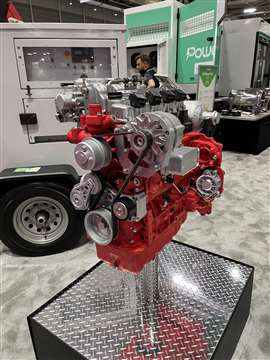 The Deutz LPG generator engine is designed to run on propane and targeted for 240V generator set applications. (Photo: KHL Staff)
The Deutz LPG generator engine is designed to run on propane and targeted for 240V generator set applications. (Photo: KHL Staff)
“Propane is a clean and reliable energy option that is ideal for prime or backup power generation systems,” Hale said. “Whether it’s a microgrid, a towable or backup generator or a combined heat and power (CHP) system, propane provides resiliency by also working in tandem with other energy sources like solar, electric and battery power to ensure continuous operation for all users.”
To prove this point, PERC hosted a panel at PowerGen bringing together representatives from several companies currently utilizing propane in their products. In introducing the panel, Hale said, “It’s exciting times to be involved with propane, and for us to be able to amplify its capability and work with increasingly more sophisticated partners to bring the value closer to the industries that they want to support.”
Drop-in fuel
Hale describes propane, and especially renewable propane, as something of a “miracle fuel” due to its minimal carbon footprint and adaptability to existing engine technology.
“There are other fuels that bring low emissions benefits but carry with them a huge technological burden,” he said. “Technically, you could design an engine to run on hydrogen that costs you millions of dollars and could take 10 years to get done. Or you could run renewable propane through that engine today without spending $1 of mechanical investment, R&D or marketing effort. The product is capable today – it’s a drop-in fuel.”
He pointed to the Deutz LPG generator engine that was displayed in the PERC booth as an example. Designed to run on propane and targeted for 240V generator set applications, the DPS 25 SG has a 20- to 30-kW prime electrical power capacity and consumes just 2 gal. per hour of fuel at 70% load.
John Dutcher, director regional sales, Deutz Corp., said the company views propane as a low-carbon solution that engine makers are working to include in their portfolio to satisfy market demand for cleaner alternatives. “As Gavin mentioned, the technology is there and supports it… We can take any diesel derivative today and potentially put propane through that as fuel.”
Propane is already common in such markets as the industrial fork truck industry. “But others are growing,” Dutcher said. “The market acceptance is fantastic, especially power generation. The size of the market is very, very attractive.”
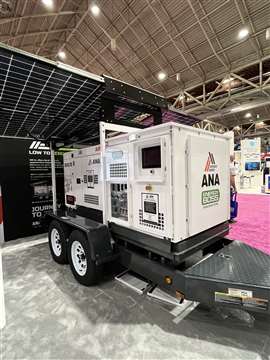 ANA’s Energy Boss is a hybrid power generation and energy storage platform that is available with a 25-kW propane generator. (Photo: KHL Staff)
ANA’s Energy Boss is a hybrid power generation and energy storage platform that is available with a 25-kW propane generator. (Photo: KHL Staff)
This is due in part to the fuel’s stability and long shelf life. “The engine in a generator can marry up to that quite well,” he said.
Brian Quock, product line manager, Power Generation and Energy Storage, ANA Inc., agreed, adding that because propane is an abundant resource, it is readily deliverable and “it’s a great alternative for power generation.”
Reduced maintenance
ANA’s Energy Boss is a hybrid power generation and energy storage platform that integrates a generator with battery technology to meet customer power demands. Models are powered by long lifecycle lithium-titanate (LTO) batteries coupled with a generator that provides a recharging current when the load is higher or for extended runtimes.
The Energy Boss displayed in the PERC booth was equipped with a 25-kW propane-fueled Juice Box generator supplied by Evergreen Mobile Power, which Quock said is “just the right amount of energy” to charge the batteries on board. It includes a 64-gal. propane tank. “That’s enough fuel to run almost two weeks at about a 3- to 5-kW load,” he noted.
“We run [the generator] probably six to seven times less per day to provide the same amount of power output,” he continued. “We’ll run about an hour and 15 minutes per generator run to charge up our batteries. Then off of our batteries, we [supply] power – either 120V, 240V all the way up to 480V – simultaneously to a jobsite, to an entertainment facility.”
Propane is not as energy dense as diesel. “But when you look at the cost of fuel, propane beats out diesel economically and also emissions wise, especially if we use renewable [propane],” Quock said.
There are maintenance benefits, as well. “We extend the life of the generators,” Quock said. “We lessen the amount of maintenance required and the number of truck rolls [required] to go out there to change the oil. We save the amount of oil that you used to supply to the [diesel] engines.”
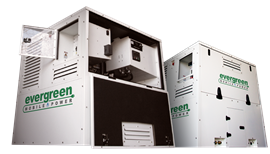 Evergreen Mobile Power Juice Box propane-fueled generator can use either propane or natural gas to provide eco-friendly, low-maintenance power. (Photo: Evergreen Mobile Power)
Evergreen Mobile Power Juice Box propane-fueled generator can use either propane or natural gas to provide eco-friendly, low-maintenance power. (Photo: Evergreen Mobile Power)
As a result, Quock said, “We think that the levelized cost of energy is going to be much greater using propane.”
Evergreen Mobile Power could have used several different sources of fuel for the Juice Box. “We chose propane for a couple of reasons. First of all, we get a green, eco-friendly technology, which enables you to take this generator to festivals… You want a cleaner platform,” said Scott Mook, sales, marketing and dealership program. “Propane also helps us with maintenance, which makes the generator more profitable for equipment rental or any other sources you’re going to use it for.”
Instead of servicing every 100 hours at a cost of about $250 per service, Mook said users only have to maintain the Juice Box every 500 hours at a cost of about $50. “That’s a tremendous savings and it makes that generator incredibly profitable.”
Propane-fueled charging
EV Power Pods can be powered by conventional or renewable propane, as well as conventional and renewable natural gas, to deliver completely self-contained DC fast charging for electric vehicles. Truck-, trailer- and skid-mounted platforms are available.
The company chose propane as a fuel for its low carbon index, ready availability and ease of storage on site. Dwain Beydler, a founder and managing principal of EV Power Pods, quoted one customer as saying: “You know what I love about the EV Power Pod – I can put it in a cornfield and forget about it. You know why? Because I can drop a 500-gal. propane tank next to it and literally forget about that cell tower.”
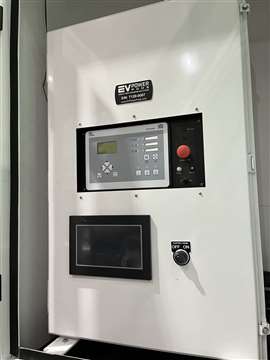 EV Power Pods, which provide DC fast charging for EVs, can be powered by conventional or renewable propane. (Photo: KHL Staff)
EV Power Pods, which provide DC fast charging for EVs, can be powered by conventional or renewable propane. (Photo: KHL Staff)
Beydler said propane is the emerging fuel of the future. “It is the means by which we can move to electrification in this country. And the EV Power Pod is the means by which electric vehicles… will be able to go across the country,” he asserted.
Propane’s ready availability and storability means the EV Power Pod can be deployed wherever it’s needed. “When you use an EV Power Pod for your migration to electrification – for your last-mile distribution for Amazon and FedEx and UPS – clean propane is the way that we can make that happen today,” Beydler said.
Power for extended outages
UpStart Power’s 1.25-kW Upgen NXG fuel cell generator is a long-duration backup system for residential and commercial use that can be deployed in combination with battery storage and solar energy (optional) for enhanced energy resilience and grid independence. During grid outages, battery storage continues to power the loads, while the fuel cell generator replenishes the battery when the sun isn’t shining.
“We all know solar power is clean, cost effective and, with the help from batteries, can run through the night and minor grid hiccups,” said Ed Lieberman, vice president, Sales, Upstart Power. “But what happens when we have to provide resilient needs for long-term outages?”
In the face of wildfires, floods, hurricanes and other scenarios that can cause extended outages, he said, “You need a reliable solution that provides not just days to carry you through these events, but keeps you operating during the cleanup, planning and rebuilding phase.
“Clearly, Upstart is a big fan of solar and battery solutions. However, while they excel during sunny times of the day, only fuels such as propane and natural gas will give customers enough energy density to handle long-term [outages] that can be counted in days, weeks and months,” Lieberman continued. “When combining the energy density of propane with the high-efficiency Upgen unit, customers can extend the duration of a standard size [generator] 10 times over a traditional internal combustion engine.
“By leveraging… propane, for the first time you have a carbon neutral and often carbon negative solution.”
Propane’s time to shine
Given such advantages, why hasn’t propane caught on more as a “fuel of the future”? According to Hale, there are a number of factors, involving commercial, logistic and, in particular, technical elements.
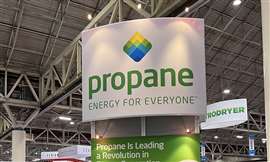 Photo: KHL Staff
Photo: KHL Staff
“Applying design standards of combustion from a new technical perspective that meets the needs of different fuels – whether it’s gasoline, diesel or propane – is actually really difficult to get that to be efficient,” he said. “For years and years, the biggest bang for the buck has been [diesel.] It’s available on every street corner. And when it was relatively unregulated, it was relatively straightforward to develop a product.”
Times have changed, however, and so have emissions requirements for diesel engines. “The technology has become really difficult for the investment, and the investment is quite high. Propane offers an alternative to that, and it meets and exceeds emissions standards, but using much simpler technology,” Hale said. “So, we kind of had to have the need from a technical perspective to move into that domain for propane to become more competitive.”
He described it as a “perfect storm coming together right now which hasn’t really existed up to this point” – a storm driven by high demand for electricity coupled with a need for abundant, low-emissions fuel that can utilize existing technology. While there has been extensive investment into new power systems, much of it is going toward technologies that he described as “ephemeral at best, intangible if you’re lucky.”
“They don’t exist yet,” he stated. “[Propane] exists today. We can meet those goals with what we have today. So, to bring this all together, this is why it’s propane’s moment.”
The score on renewable propane
According to PERC, renewable propane is quickly becoming a viable energy source for power needs. Made from a variety of renewable feedstocks, such as camelina plant oil (a non-food crop), used cooking oil or animal fats, the carbon intensity (CI) of renewable propane scores between 20.5 and 43.5 grams of carbon dioxide equivalent per megajoule (gCO2e/MJ), depending on the feedstock. Comparatively, the CI score of conventional propane is 80 gCO2e/MJ, diesel is 100 gCO2e/MJ and gasoline is 101 gCO2e/MJ.
“With half the carbon intensity of standard propane, renewable propane is making the path to zero and near-zero emissions attainable within the next 15 years,” said PERC’s Gavin Hale.
Because its chemical structure and physical properties are the same as traditional propane, the renewable variant can be used for the same applications without modification to engines or equipment. It can be used alone or in blends with other low-carbon energy sources, including conventional propane, further reducing carbon emissions without sacrificing performance, PERC said.
“Propane is clean, and renewable propane is cleaner,” said Hale. “It delivers today the capability to be more environmentally friendly than hydrogen. The question is ramping up production.”
In 2023, 4 million gal. of renewable propane was produced compared to 10 billion gal. of conventional propane. “It’s economy of scale,” said Hale. “The more we produce, the lower the cost.
“Initially, we have to be selective where we deploy it, targeting how we do it,” he continued. “Over the next two years, you’ll see the proliferation go higher, and it will be deployed in areas where it’s going to be of most benefit.”
POWER SOURCING GUIDE
The trusted reference and buyer’s guide for 83 years
The original “desktop search engine,” guiding nearly 10,000 users in more than 90 countries it is the primary reference for specifications and details on all the components that go into engine systems.
Visit Now
STAY CONNECTED




Receive the information you need when you need it through our world-leading magazines, newsletters and daily briefings.
CONNECT WITH THE TEAM











